Course:How Diving Tourism Affects the Health of Coral Reefs
What is the problem?
Ecotourism
Ecotourism as a concept is hard to define due to the ambiguity surrounding its historical origin. In the early 1980s, Ceballos-Lascuráin defined ecotourism as “traveling to relatively undisturbed or uncontaminated natural areas with the specific objective of studying, admiring, and enjoying the scenery and its wild plants and animals, as well as any existing cultural manifestations (both past and present) found in these areas''. During this decade ecotourism was confined by a range of destinations to visit as well as a market of mainly birdwatchers and scientists, as well as conservation organizations, interested in this kind of experience. Therefore, the tourists were mainly well educated, financially well off Allocentric people who would stay in the areas for long periods of time (Fennell, 2015).[1]
Ecotourism is about bringing together conservation, community and sustainable tourism. This means that those who implement, participate in ecotourism and ecotourism activities must adopt ecotourism principles (The International Ecotourism Society, 2019).[2]
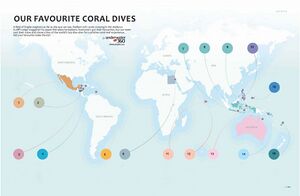
Currently, ecotourism continues to be accepted as the antithesis of mass tourism because of its promise of achieving sustainability. The extent to which this promise has been realized is open to debate (Fennell, 2015).[1].
Although today ecotourism is still considered a fairly minor component of the total global travel demand, its growing rate is considered one of the fastest in the tourism sub-sector[4]. In the publication The Tourist Gaze 3.0[5] it is stated how the future of ecotourism is still uncertain for the 22nd century since there is an essential paradox within the concept and its supposedly non-consumptive nature.
Diving ecotourism
Marine tourism is a major contributor to local economies of both developed and developing countries. Diving ecotourism is a form of marine tourism that is based on marine ecosystems and is considered a promising sector of tourism. Diving tourism requires effective management to protect ecological and cultural values and ensure the sustainable use of natural resources (Maripas-Polymeris et.al.,2019).[6]
How does diving affect coral reefs?
Coral Reefs
Coral reefs are a prominent example of the complexity of marine ecosystems, and one of the world’s most popular spots for tourist diving, due to its beautiful corals and colorful reef fish. Corals have endosymbiotic algae, called zooxanthellae, that use photosynthesis to provide themselves and corals with nutrients.[7] Coral reefs provide valuable shelter and nutrition to various invertebrates, fish, birds, and marine mammals. Diving ecotourism in these vulnerable ecosystems may have negative consequences for coral and fish communities.[8]
Changed Behaviors
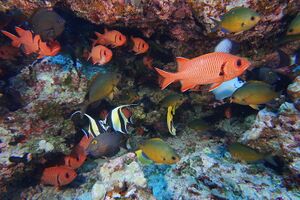
Diving ecotourism affects coral reef ecosystems and any of the organisms in it. In one study, white-tip reef sharks were found to display different behaviors when diving boats were present. During the day, sharks tend to maintain one depth as they rest, and change depth more frequently during the night. However, when tourist diving boats were nearby, sharks showed increased variation in their depths, meaning they were interrupted during their natural resting hours[9]. This could have long-term negative effects on the health of white tip reef sharks, as the disruption in circadian rhythms could be detrimental to their wellbeing.
A study on reef fish, which are one of the main reasons for reef popularity with tourists, found that the presence of divers decreased the abundance of several species. After an initial count by divers, the number of different species was found to have decreased by anywhere from 24 to 73% upon returning after a brief rest[10]. The abundance of each species decreased as well, though the effects differed between species; herbivorous species, such as rabbitfish and parrotfish, all decreased in abundance significantly, while some other species did not face the same effects[10].
For the marine organisms on coral reefs, the reef provides safe habitat with many places to hide from predators. Many species are endemic to their coral reef, and could not survive outside of it. According to the National Ocean and Atmospheric Administration, about 25% of all fish are reliant on coral reefs for various essential life processes, such as feeding and reproduction[11]. This means that the disturbances from ecotourist diving groups could seriously impact the natural behaviors of many species habituating coral reefs, resulting in a possible decline of certain species that are vulnerable to predators.
Characteristics of organisms
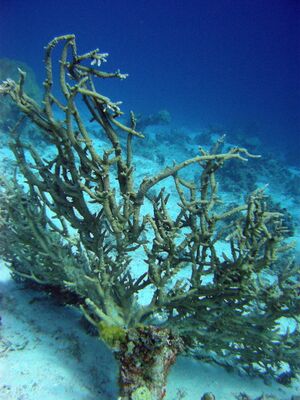
Coral primarily grows from calcium carbonate secreting and creating branches and polyps. When these branches are broken off or otherwise damaged (scraped, bumped, even just touched in some cases)[12], the coral can experience significant declines or a complete stop to reproduction and growth. Coral also has been found asphyxiated from turned up sediments from divers disturbing the sea floor, since sediments often have benthic organisms in the dust due to the shallow and often sunny nature of reefs. These organisms will cover the coral completely and not allow any oxygen transfer. Coral's "shut-down mechanism"[13] is understood to be a highly contagious disease that leads to "spontaneous disintegration of the tissue that can kill a coral fast"[13]. It is responsible for the removal of protective mucus that protects the coral from diseases and is triggered sometimes by just a touch. This effect is devastating because coral is quite slow to regrow often, taking multiple decades to repair damages sustained.
How is this problem impacting marine ecosystems?
The Philippines: A Positive Impacts Case Study
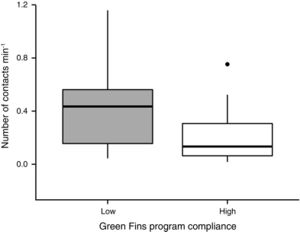
In the Philippines (Malapascua Island, Moalboal, Puerto Galera) the damage to coral reefs by divers instructed by Green Fins Programme standards and those who did not follow this programme was investigated by measuring the number of contacts divers made with the reef[14]. Contacts are instances where divers or their equipment touches the reef, which can result in damage to coral.
THE GREEN FINS PROGRAMME[15]
The Green Fins Programme provides a code of conduct for dive operators to follow. This code of conduct includes both instructions for dive operators themselves, such as regularly taking part in beach or underwater cleanups, as well as instructions on how to educate their divers about marine ecosystems. See the code of conduct here.
Did the Green Fins Programme Help?
The Green Fins Programme significantly reduces the damage of recreational diving to the reef, and can even improve its health by other means. It would be interesting to see whether over longer timescales the reef’s health improved, but this information would only be available in the future since these diving practices have not been implemented for very long. The assumption, however, would be that since the number of contacts was reduced in those areas where there is a high compliance with the Green Fins Programme, and more effort into restoration is being done, the reef would begin to flourish.
Hong Kong: A Negative Impacts Case Study
In Hong Kong’s eastern reefs, specifically near Sharp Island, diving is associated with coral breakage due to behaviour of divers.
In the first study, divers in Hong Kong were divided into groups and watched underwater and it was seen that inexperienced divers and photographing divers are often the groups causing the most damage, pushing the reef past the amount of wear and tear it can normally handle. In the study, many divers were not certified, and it is not uncommon for instructors to use reefs as training grounds, which should be discouraged given the results[16].
| SIte | No. of genera | Distance (min) | No. of divers | Broken coral colonies | % broken colonies |
|---|---|---|---|---|---|
| Sharp Island | 15 | 20 | 2667 | 19 | 21.8 |
| Shelter Island | 13 | 45 | 1259 | 18 | 11.7 |
| Bluff Island | 11 | 60 | 490 | 16 | 10.7 |
| Long Ke | 12 | 90 | 1080 | 13 | 10.4 |
| Hoi Ha | 15 | 150 | 118 | 9 | 6.5 |
| Port Island | 11 | 150 | 138 | 3 | 4.0 |
| Crescent Island | 9 | 180 | 98 | 3 | 3.7 |

This table[17] shows the relationship between the amounts of damaged coral and divers, as well as the dominating types of coral
This table above shows an increase in damaged coral and frequented diving sites The effects of this can be seen in the second study, which looked at the coral itself and the change taking place in Hong Kong waters. Coral was divided into four types, branching, plate-like, massive and encrusting, and breakage was measured from these four types. Sharp Island was found to have 21% of the total broken coral found among islands. Not coincidentally, it was also the most accessible and popular diving spot in both studies[17]
A conclusion that can be drawn from the table is the more diverse coral reefs are most popular and most susceptible to damage. It is important to note that most of the damage seen pointed towards divers; small breakage and surface lesions, and only a small portion were from anchor damage. These small damages may not seem like much but they add up over time, and invite attack from predators. Since the coral that is more breakable will be attacked, biodiversity of coral is decreasing and unnatural domination of stronger coral is present. There is evidence of this change already complete in some sites[17].
What is the extent of the problem?

Ecotourism is a rapidly expanding industry, driven by rising interest in environmentally friendly travel and a desire to observe marine life and the natural world in their native settings. However, if ecotourism is not handled responsibly, it may potentially have detrimental effects on the environment and nearby communities (Kiper, 2013)[18]. For example, if too many boats are allowed to operate in a small area, this can disturb feeding and mating patterns of marine animals, leading to stress and potentially reduced populations. Additionally, increased human traffic in these areas can lead to increased pollution. One example that sticks out is the pollution sunscreen causes. Certain ingredients in sunscreen have been found to be harmful to coral reefs and marine life. These chemicals can lead to coral bleaching, which can devastate marine ecosystems and negatively impact the natural beauty that attracts ecotourists (Tibbetts, J. 2008)[19]. As a result, many popular ecotourism destinations, such as Hawaii and the Great Barrier Reef, have implemented bans or restrictions on the use of sunscreens containing these harmful chemicals.
In particular, marine ecotourism can place significant pressure on marine ecosystems and the species that depend on them, particularly in tourist-heavy locations where activities such as snorkelling and scuba diving can have negative effects (Libretexts, 2022)[20]. The issue of ecotourism is complex, as it provides economic benefits to local communities and has the potential to conserve marine life and ecosystems, but it can also lead to negative impacts if not managed sustainably (Libretexts, 2022)[20].
Diving impact throughout the years
Following a new low in the past 8 years in 2020, the SCUBA diving market is expected to be entering a new period of growth and it will continue to do so until 2025 (Kieran, 2020).[21] Since its quick expansion in popularity in the 1980s, SCUBA diving has consequently increased the demand of marine resources on the places it is practiced.
As an important tourism market, generating a billion-dollar industry worldwide in 2016 (Lucrezi, 2016).[22] It is estimated that there exist about 13,181 recreational diving places around the world with the largest number of sites situated in Europe, this represented around 20% of the recreational diving sites in 2012 (Lew, 2013). [23].

| Region | Number | % |
| Europe | 2583 | 19.6 |
| North America | 2176 | 16.5 |
| Asia | 1814 | 13.8 |
| Middle East and Africa | 1729 | 13.1 |
| Caribbean | 1394 | 10.6 |
| Australia and New Zealand | 1278 | 9.7 |
| South Pacific | 1113 | 8.4 |
| Middle and South America | 1094 | 8.3 |
| Antartica | 0 | 0.0 |
| Total | 13,181 |
Furthermore, it is estimated that during the past 20 years, around 900,000 people received a Professional Association of Diving Instructors (PADI) certification, either newly awarded or by continuing education. It is safe to say that SCUBA diving has been a growing industry for the past 40 years which has brought economic benefits for those involved (Merino, 2021).[14]
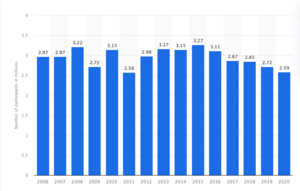
Over time, however, SCUBA diving has contributed to the change of marine ecosystems. Some of the reasons for this are repetitive and cumulative contact that divers exert on the seafloor, as a result of incorrect SCUBA practices by divers, diving guides, and dive providers.[14]. Impacts include physical damage that could interfere with biological and ecological processes and even contribute to fragile or rare species loss. Moreover, SCUBA diving is commonly referred to as having direct impacts on the environment that can easily be perceived and physical impacts that leave a mark, such as breaking or moving something from the bottom of the ocean. Thus, it is said that SCUBA diving has different kinds of impacts known as “pulse” and “pressure”. The first one are short-term intense episodes, while the latter are persistent and chronic impacts (Merino, 2021)[14]. The magnitude of the impact is related to the frequency, type of use and associated behaviors of the action causing the impact, in the case of SCUBA diving, the impact can be estimated with data such as the number of participants or the number of diving sites as seen in Figure (Merino, 2021).[14]
Although recreational scuba diving has generally been perceived as an activity with low environmental impact, the rapid growth in popularity of diving, concerns have arisen that some heavily-dived sites may have diver visitation rates approaching the limit of ecological sustainability (Harriot, 2015).[25] An example of this is shown in recent studies which link this increase in the amount of recreational divers to an increase in coral mortality and spatio-temporal variability with marine protected areas (MPAs) (Hayes, 2017). [26]
Additional studies in the northern Red Sea indicate that over-use of dive sites can lead to unsustainable levels of coral damage, regardless of the site’s topography. In addition to causing environmental degradation, recreational swimming and diving can cause unintended behavioral changes in marine Macrofauna. An example of this is found is Constantine (2001)[27] who studied swim-with-dolphin tourism in the Bay of Islands, New Zealand, and found that large numbers of human swimmers (31 swimmers approaching one individual per year) can cause bottlenose dolphins (Tursiops truncatus) to become sensitized to humans and lead to reduced dolphin foraging, resting, nursing and socializing behavior.
Given the impact, what are the solutions?
Diving Education
Scale: local
Educating new divers on the value and conservation of coral reefs seems to be the most feasible solution at the moment. Since in many cases the cause of reef damage during diving is by fin contact, which stems from poor buoyancy, it would be greatly helpful to have an extended diving session in the pool first, before going out to sea. Not only should they be trained physically for the conditions, they should also be educated about the value of the marine ecosystem they are entering. Hence they’ll have additional incentive to be extremely mindful of their surroundings. Luckily most diving centres already have the staff and infrastructure to do this, so it would be relatively inexpensive to initiate[28].
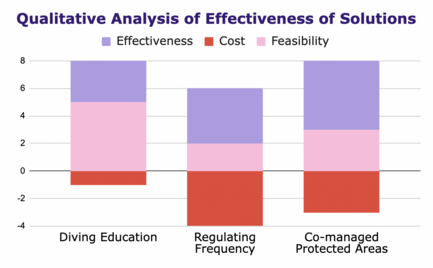
Regulate Frequency
Scale: local
If the number of diving trips, and the number of people on each one, was set below the ‘sustainable limit’, this issue could theoretically be completely solved. Not only would the damage from diver contact with the reef be reduced, the damage from the boats going out on trips and anchoring would be mitigated too[29]. The maximum sustainable number of dives per year for a region would be calculated, and the number of dives per week regulated based on said figure. However, extensive research would need to be done to determine the sustainable limit of each region. Doing research means high cost, and will require a significant amount of time. Furthermore, regulating the number of dives will likely impact tourism. Consequently countries whose economies rely on ecotourism will oppose such regulations as it will likely diminish their economic prosperity.
Co-managed protected areas
Scale: global
Co-managed protected areas are those that are managed by a combination of government and local rural inhabitants. This is because the government's interests mainly lie in the economy, while the rural inhabitants are more affected by the environment, and will therefore be acting in its interests. This management strategy would be most effective at reducing damage to the reef[28]. It would, however, require the stakeholders involved to cooperate, and would need significant financial investment as new departments must be created and more people need to be hired, etc.
Conclusion
Coral reefs are incredibly complex ecosystems that provide a home to a wide range of marine organisms, including fish, invertebrates, and mammals. Activities such as Diving is popular in coral reef ecosystems which pose risks to both the divers and the marine life they encounter. While advancements in technology and training have increased safety and efficiency in diving, it is important to prioritize environmental sustainability and responsible management practices to ensure that coral reefs and the organisms they support are not further degraded by diving activities. This can be achieved through measures such as proper training, effective regulation, monitoring, as well as taking an active role in protecting the marine environment and advocating for sustainable practices. By implementing sustainable management practices in both marine life ecotourism and diving, we can preserve and protect our ocean ecosystems for future generations to enjoy.
References
- ↑ 1.0 1.1 Fennell, David A. (2015). Ecotourism. Bungay, Suffolk: Routledge. pp. 3–21. ISBN 978-0-203-38211-0.
- ↑ "What is Ecotourism?". The International Ecotourism Society. 2019.
|first=missing|last=(help) - ↑ UW360 (Jun. 19, 2019). "Our favourite coral dives". Underwater360. Retrieved Feb. 23, 2023. Check date values in:
|access-date=, |date=(help) - ↑ Sharpley, Richard (2015). Ecotourism. Lancashire, UK: John Wiley & Sons, Ltd. ISBN 9780470672846.
- ↑ Urry, John (2011). "The Tourist Gaze 3.0".
- ↑ Maripas-Polymeris, Georgios; Kounani, Aristea; Seleventi, Maria K; Skanavis, Constantina (2019). Diving Ecotourism as Climate Change Communicating Means: Greek Diving Instructors’ Perceptions. Springe, Cham. pp. 435–455. ISBN 978-3-030-32898-6.
- ↑ U.S. Department of Commerce. (2013, June 1). Zooxanthellae...what's that? Corals Tutorial. National Ocean and Atmosphere Administration. Retrieved February 8, 2023, from https://oceanservice.noaa.gov/education/tutorial_corals/coral02_zooxanthellae.html#:~:text=The%20zooxanthellae%20cells%20use%20carbon,with%20food%20resulting%20from%20photosynthesis
- ↑ Zulaiha, Z., & Mohamed, B. (2014). A Review of SCUBA Diving Impacts and Implication for Coral Reefs Conservation and Tourism Management. SHS Web of Conferences, 12. https://doi.org/10.1051/shsconf/20141201093
- ↑ Fitzpatrick, R., Abrantes, K.G., Seymour, J. et al. Variation in depth of whitetip reef sharks: does provisioning ecotourism change their behaviour?. Coral Reefs 30, 569–577 (2011). https://link.springer.com/article/10.1007/s00338-011-0769-8
- ↑ 10.0 10.1 Emslie MJ, Cheal AJ, MacNeil MA, Miller IR, Sweatman HPA. 2018. Reef fish communities are spooked by scuba surveys and may take hours to recover. https://peerj.com/articles/4886/
- ↑ U.S. Department of Commerce. (2019, February 1). Coral Reef Ecosystems. National Oceanic and Atmospheric Administration. Retrieved February 8, 2023, from https://www.noaa.gov/education/resource-collections/marine-life/coral-reef-ecosystems
- ↑ Zainal Abidin, S. Z., & Mohamed, B. (2014). A Review of SCUBA Diving Impacts and Implication for Coral Reefs Conservation and Tourism Management. SHS Web of Conferences, 12, 01093. https://doi.org/10.1051/shsconf/20141201093
- ↑ 13.0 13.1 Mercado-Molina, A. E., Sabat, A. M., & Hernández-Delgado, E. A. (2020, January 1). Chapter Three - Population dynamics of diseased corals: Effects of a Shut Down Reaction outbreak in Puerto Rican Acropora cervicornis (B. M. Riegl, Ed.). ScienceDirect; Academic Press. https://www.researchgate.net/publication/346140775_Population_dynamics_of_diseased_corals_Effects_of_a_Shut_Down_Reaction_outbreak_in_Puerto_Rican_Acropora_cervicornis
- ↑ 14.0 14.1 14.2 14.3 14.4 14.5 Roche, Ronan C. (April 7 2016). "Recreational Diving Impacts on Coral Reefs and the Adoption of Environmentally Responsible Practices within the SCUBA Diving Industry". Environmental Management. 58: 107–116 – via Springer. Check date values in:
|date=(help) Cite error: Invalid<ref>tag; name ":3" defined multiple times with different content - ↑ "About Green Fins". Green Fins.
- ↑ Chung, Ss; Alfred, Au (2013). "Chung, Ss., Au, A. & Qiu, JW. Understanding the Underwater Behaviour of Scuba Divers in Hong Kong. Environmental Management 51, 824–837 (2013). https://doi.org/10.1007/s00267-013-0023-y". Environmental Management. 51: 824–837 – via SpringerLink. External link in
|title=(help) - ↑ 17.0 17.1 17.2 17.3 Au, A. C.-sun (2014). "Diving associated coral breakage in Hong Kong: Differential susceptibility to damage". Marine Pollution Bulletin. 85: 789–796. – via Elsevier Science Direct.
- ↑ (Accessed: March 8, 2023) https://www.intechopen.com/chapters/45414 (Accessed: March 8, 2023) Check
|url=value (help). Missing or empty|title=(help) - ↑ (Accessed: March 8, 2023). https://www.ncbi.nlm.nih.gov/pmc/articles/PMC2291012/ (Accessed: March 8, 2023). Check
|url=value (help). Missing or empty|title=(help) - ↑ 20.0 20.1 https://bio.libretexts.org/Bookshelves/Marine_Biology_and_Marine_Ecology/A_Student's_Guide_to_Tropical_Marine_Biology/04%3A_Reef_Conservation/04.5%3A_Ecotourism%2C_Recreation%2C_and_Reefs. Missing or empty
|title=(help) - ↑ Kieran, Darcy (September 19, 2020). "The Scuba Diving Industry 2020–2021: How bad is it? What's next?". Medium.
- ↑ Lucrezi, Serena (January 17, 2016). "How scuba diving is warding off threats to its future". The Conversation.
- ↑ 23.0 23.1 Lew, Alan A (2013). "A world geography of recreational scuba diving". Scuba Diving Tourism. London: Routledge. ISBN 9780203121016.
- ↑ "Number of participants in scuba diving in the United States from 2006 to 2020(in millions)".
- ↑ Harriot, Vicki; Davis, Derrin; Banks, Simon. "Recreational Diving and Its Impact in Marine Protected Areas in Eastern Australia" (PDF). Springer.
- ↑ Hayes, Christian; Baumbach, Dustin S; Juma, David; Dunbar, Stephen G (2017). "Impacts of recreational diving on hawksbill sea turtle (Eretmochelys imbricata) behaviour in a marine protected area". Journal of Sustainable Tourism: 79–95.
- ↑ Constantine, R (2001). "Increased avoidance of swimmers by wild bottlenose dolphins (Tursiops truncatus) due to long-term exposure to swim-with-dolphin tourism". Marine Mammal Science. 17: 689–702.
- ↑ 28.0 28.1 Merino, Natalia (June 1 2021). "Impacts of Recreational SCUBA Diving on a Natural Area in Puerto Vallarta, Mexico". Sustainability. 13 – via MDPI. Check date values in:
|date=(help) - ↑ Harriott, Vicky (May 1997). "Recreational Diving and Its Impact in Marine Protected Areas in Eastern Australia". Springer. 26: 173–179 – via JSTOR.